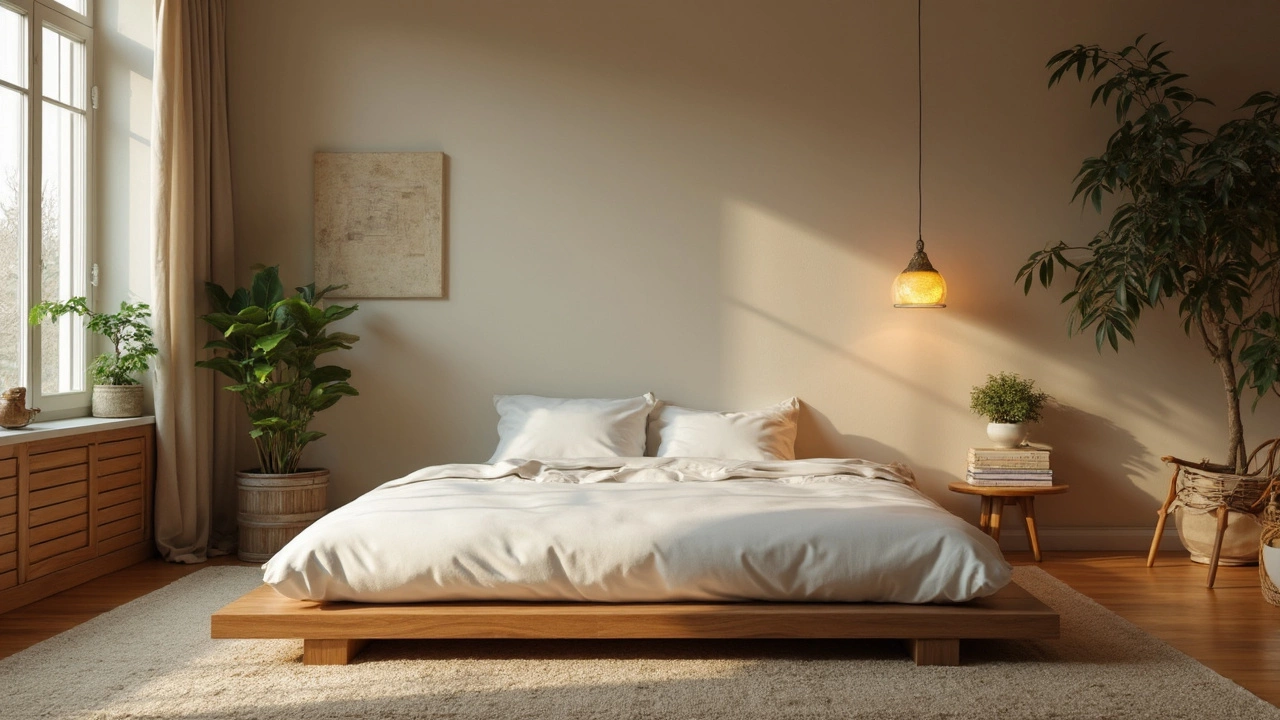If you've been hopping on the minimalist trend train, you might find yourself curious about Japanese bedding. It's not just a style; it’s a whole lifestyle shift. Instead of those giant, space-eating beds we've grown up with, we're talking futons—those sleek and lightweight mattresses that you just roll out at night and stash away during the day. Convenient, right?
These futons are typically made from cotton, making them super breathable and ideal for all seasons. They're laid directly on tatami mats—a traditional Japanese flooring—or directly on your bedroom floor if you're aiming for that authentic vibe. This setup means you’ve got loads more room during the daytime. Ever dreamt of having a spontaneous dance-off or just some quality stretching space? Japanese bedding's got your back.
- Traditional Japanese Bedding: The Futon
- Materials and Make: What Goes into a Futon
- Benefits of Japanese Bedding
- Setting Up Japanese Bedding at Home
- Modern Takes on Traditional Concepts
Traditional Japanese Bedding: The Futon
Alright, let's break down what a futon really is. In Japan, a futon isn't your typical heavy mattress. It's actually a lightweight, easy-to-roll-up mattress-blanket combo that you lay on the floor. It’s designed for those who appreciate simplicity and versatility.
The classic futon setup involves a few key components: the shikibuton and the kakebuton. Shikibuton is the mattress part, and the kakebuton acts as the comforter. Often, there's also a supportive pillow known as a makura. The whole set is about giving you comfort without all the hassle of a giant bed frame.
Historically, these futons are crafted using natural materials like cotton, which is used for its breathability and durability. Modern versions might incorporate a bit of polyester for added resilience, but the essence remains the same. It’s about keeping things simple and natural.
One of the reasons Japanese bedding is still a thing today is because of its space-saving magic. Imagine being able to turn your bedroom into a yoga studio by simply stacking up your bedding in the closet. That's the kind of versatility we’re talking about.
And here's something cool: rocking a futon might actually be good for your back. Sleeping on a firm enough surface ensures better spinal alignment and less tossing and turning. If you're a minimalist at heart, or just someone who loves a tidy room, giving Japanese bedding a shot could be a game-changer.
Materials and Make: What Goes into a Futon
When it comes to Japanese bedding, knowing what's inside these simple yet comfy creations is like seeing the magic behind the curtain. The core of a futon is usually made of layers of cotton, wool, or synthetic fibers. The idea is to keep it lightweight and breathable—perfect for someone dreaming of a good night's sleep without overheating.
Cotton's a popular choice because it's natural and lets your skin breathe. Pretty neat, huh? If you’re looking to invest in a futon and worried about allergies, don't sweat it. Many brands offer hypoallergenic options. Quite thoughtful, right?
Now, the cover is just as important. It usually consists of cotton or linen, materials known for their softness and durability. You'll want something that feels cozy against your skin after a long day, and these fabrics do the trick. Plus, they’re easy to clean. Spill some tea? No problem—just zip off the cover and toss it in the wash.
- Futon Mattress: Layers of cotton, wool, or synthetic fibers for core comfort.
- Covering: Made of durable cotton or linen for softness and easy cleaning.
- Layers: Some futons come with two or three, providing varying levels of firmness.
Whether you're going full-on traditional or opting for a modern twist, the materials in your futon can seriously level up your comfort game. These choices aren't random either—they've been perfected over centuries until only the best became standard. So next time you stretch out on a futon, you'll know just what’s going into that little slice of heaven.

Benefits of Japanese Bedding
Switching to Japanese bedding can be a game-changer if you're looking to maximize comfort and practicality. It's not just about the aesthetic appeal of minimal design; there are some real perks to it that might just convince you to make the switch.
First up is comfort. These futons have a reputation for being kind to your body. Since they're placed directly on the floor or tatami mats, Japanese bedding helps promote a better sleeping posture, potentially reducing back pain. That's a relief in more ways than one!
Next, let's talk about the space-saving element. Without a bulky bed frame hogging room, your living space opens up drastically. Imagine transforming your bedroom into a spacious hangout by simply rolling up your futon. It's a win-win: you get to declutter and optimize your room's functionality.
The environmental impact is another big plus. Many futons are made from natural materials like cotton, which are more eco-friendly than some synthetic counterparts found in traditional mattresses. So, if you're aiming for a greener lifestyle, this one's a step in the right direction.
You might be surprised at how budget-friendly Japanese bedding can be. Not only are they generally cheaper than traditional beds, but they also last quite a while if you take good care of them. A quick airing-out now and then, and you're golden!
Lastly, there's something incredibly satisfying about the simplicity and flexibility of Japanese living. Sure, it's a big change if you're used to beds with loads of pillows and duvets, but the minimalist atmosphere it creates is almost like a daily meditation session for your home.
Setting Up Japanese Bedding at Home
So, you're ready to give Japanese bedding a whirl at home? Awesome choice! Not only do you get to enjoy the comfort of a futon, but you also get to embrace a whole new way of living.
First things first, let's talk about the basics—getting the right futon. You want something that's plump and cozy, usually made from multiple layers of cotton. This helps it stay firm yet comfortable.
Next, you'll need a suitable place to lay your futon. Traditionally, futons are placed on tatami mats. These mats are usually made of rice straw and give a little cushioning under your mattress. If you're not in Japan, no worries! You can throw it on any clean, preferably wooden or carpeted floor.
"A well-maintained futon can last up to a decade. Proper care is key to its longevity," notes renowned lifestyle blogger, Sakura Yasuharu.
Once rolled out, the futon becomes your bed for the night. But here’s the magic part: come morning, it goes right back into its storage mode. This means a tidy, uncluttered room for the rest of the day.
- Cleaning Tip: Air out your futon weekly by hanging it outside on a sunny day. This keeps it fresh and fluffy.
- Storage Tip: When you roll it up, keep it in a dedicated storage bag to protect it from dust and pests.
- Space-Saving Tip: Think vertical! Use stackable storage solutions to keep your room open and airy.
One added advantage? Flexibility! Got a guest coming over? Your futon's good to go as an impromptu sofa bed. That's the beauty of Japanese bedding, it adapts to your needs, effortlessly.
There’s something seriously satisfying about seeing a neatly folded futon in the corner of a room. Not to mention, the positive vibes from all that extra space will make your home feel twice its size. Give it a try, and soon enough, you might just find yourself converting every room!

Modern Takes on Traditional Concepts
Mixing the old with the new is how we roll these days, right? When it comes to Japanese bedding, the same practice holds true. As minimalism spreads, more folks are blending the classic futon approach with today’s comfort needs, creating a fascinating blend that’s both stylish and practical.
Many trendy city apartments, especially in places like New York and London, are embracing this fusion. Homeowners are picking futons with upgraded materials like memory foam layers or environmentally-friendly latex, hidden within traditional cotton covers. This gives you that snug feel of a modern mattress without losing the lightweight simplicity.
Also, accessories play a big role here. Think low-profile platform beds designed to perfectly house a futon, giving you a slightly elevated sleeping experience. They’re great for adding just the right amount of elevation while sticking to that minimal aesthetic.
- Memory Foam Futons: Provides added support, and it's great for those who love the minimalist aspect but need more back support.
- Layered Bedding: Stacks of lightweight duvets or quilts can adapt to seasonal changes easily, keeping your bedding just as flexible as a traditional futon setup.
- Stylish Accessories: Tatami-inspired rugs and folding screen dividers help recreate a modernized Japanese vibe without going full traditional.
In the style department, the color palette’s pretty neutral, loaded with earth tones. Whites, beiges, and muted greys do the trick, creating serene spaces perfect for chilling out. For those keen on a splash of pizzazz, throw pillows in indigo or subtle florals can keep things exciting yet rooted in simplicity.
Curious about combining any of these ideas into your living space? You’re not alone. The demand for these modern interpretations is on the rise, with brands offering customizable options to fit varied tastes and space constraints.


Write a comment